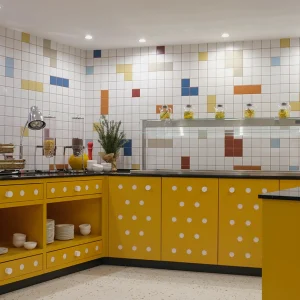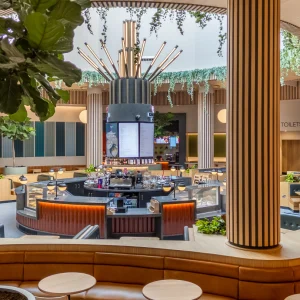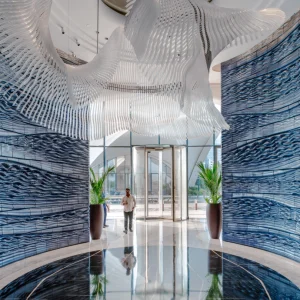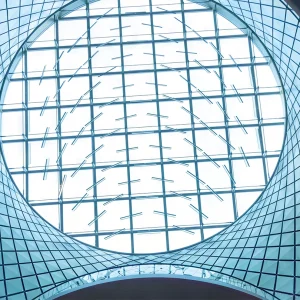
When I started writing about lighting and lighting design in the late Eighties, Derek Phillips, then principal of the practice he founded, DPA Lighting Design, was one of the first practitioners I interviewed – and I marvelled at photographs of his sensitive and imaginative schemes. Twenty five years ago you could probably count the number of UK independent lighting design practices on one hand, but Derek’s practice was long established in the field – and had a huge reputation for the quality and quantity of its work, both in the UK and abroad.

Derek Phillips continued to enjoy sailing after retiring in 1993
Derek was born in the UK in 1923 but spent much of his formative years in India, where his father worked for the Imperial Bank of India. At the age of five he was sent back to England for several years of boarding-school education – a lonely experience, largely away from his parents, that greatly influenced his approach to parenting, so that when he became a father himself he spent as much time as possible with his children.
In 1942 Derek was called up to the Fleet Air Arm of the Royal Navy during the Second World War – and later trained for the Navy’s first Night Fighting Squadron. There he made friends with Lieutenant Dennis Thornley, a qualified architect, who influenced him to study architecture after the war, a career that seemed to combine both art, which he already enjoyed, and science, which he felt he should know more about. When Derek left the Royal Navy he went on to Liverpool University to study architecture. There Derek met and married Diana Hesketh in 1952 and they subsequently had five children – Starkie, Adam, Rebecca, Jemima and Amelia. Sadly Starkie died in 2002 and Derek’s wife and soul mate, Diana, died earlier this year.

The Hasbro European HQ, Stockley Park, London, lit by DPA in 1989
After completing his studies in Liverpool, Derek received a Commonwealth Fund Fellowship to study daylighting and architecture at graduate level at Massachusetts Institute of Technology (MIT). It was during his time in the United States that Derek met with several architecture greats, including Le Corbusier, Walter Gropius, Mies van der Rohe and, most importantly to him, Frank Lloyd Wright, whose work was a powerful influence on his own. As Derek himself explained, ‘Frank Lloyd Wright was wonderful. He hated officialdom and would talk to students for hours. He also claimed to have invented concealed lighting.’
Derek also met up with American lighting design luminary, Howard Brandston, with whom he worked on some early projects – and who recently described him as ‘a Renaissance man’. Brandston remained a good friend throughout his life -and visited Derek only a few weeks before he died. Returning to the UK in 1954, Derek found little work for architects in austerity Britain, so he joined a lighting company, British Thompson Houston (BTH) as a product development consultant. His four years with BTH served as his apprenticeship in lighting technology and added another skill to his career portfolio – the most important one, as it turned out. As he himself put it, at the time ‘Although architects in the Fifties knew a lot about daylighting, they knew bugger all about artificial lighting.’

City Plaza II, Hong Kong (1968)
In 1958, frustrated by being compelled to use only BTH products for the British Exhibition in Copenhagen, Derek left and set up Derek Phillips Lighting Consultants in High Wycombe, the forerunner to DPA. This was the UK’s first independent lighting design practice, offering lighting design consultancy free from the commercial constraints of equipment supply – although Derek was still forced to take on architecture commissions alongside his growing portfolio of lighting projects. The practice motto was a quotation from John Christie, founder of Glyndebourne Opera: ‘Don’t be satisfied with the best you can do but do the best that can be done’.
Derek’s big break came a year later when he was asked to design the lighting for the liner SS Oriana – and this was followed by work with Denys Lasdun’s practice on a building for Esso. Then in 1963 he went to work on the prestigious Mandarin Hotel in Hong Kong and two years later designed the floodlighting for Westminster Abbey.
In the early Sixties too he helped to educate a new crop of building professionals at the Regent Street Polytechnic and The Bartlett School of Architecture – and this educational effort was supplemented by the publication in 1964 of the first of his many books, Lighting and Architectural Design. This was followed two years later by Lighting for the British Design Council, which explained the principles and planning of home lighting to domestic consumers.

The ocean liner SS Oriana (1959)
In the Seventies lighting design work was sparse and Derek had to fall back on his architecture skills, but in the early Eighties he set up an office in Hong Kong, whose workload flourished both here and in mainland China. Projects included the Academy for Performing Arts, the Macau Ferry Terminal, and the refurbishment of the Mandarin Oriental Hotel he had originally worked on in the Sixties.
Back in the UK, DPA as it was by then, was well placed to benefit hugely from Britain’s design and construction boom in the early Eighties – notable, award-winning projects from that period include the new Stirling Hotel at Heathrow Terminal 4 and the 19th-century Durbar Court and Locano suite at the Foreign & Commonwealth Office in Whitehall, contrasting projects that demonstrated that Derek was equally at home lighting modern structures and heritage buildings.
By this time Nick Hoggett, DPA’s current principal, had joined Derek as an assistant designer and was well groomed to take over the company when Derek retired, which he did on his 70th birthday in 1993. Three years earlier, he had appropriately enough delivered the inaugural Waldram Lecture, entitled ‘City Lights’.

The Mandarin Hotel, Hong Kong (1963)
Most admirably, retirement did not slow him down – in the next few years, when he wasn’t sailing his boat around European waters with his wife, he wrote his own autobiography, Five Careers and a Dog, plus a quartet of authoritative guides for the Architectural Press on daylighting, the lit environment and lighting design for modern and historic buildings. Well into this millennium he could be seen at lighting industry events of all kinds and was always very friendly and most generous with his time and his ideas.
In particular he took a leading role in the CIBSE Daylighting study group, but over the years he had been chairman of the Hertfordshire Association of Architects, a RIBA council member, president of the Illuminating Engineering Society (IES) and vice-president of the International Association of Lighting Designers (IALD). The IALD made him a Fellow in 2001 and in 2009 he was presented with the IALD Lifetime Achievement Award, which recognises true pioneers and visionaries in the lighting design field. The hundreds of lighting design professionals now making their living in the UK owe him a great debt.
I give the last word on Derek Phillips to Andre Tammes, co-founder of the UK’s second independent lighting design consultancy, Lighting Design Partnership (LDP): ‘Derek was, above all, a gentleman, ever courteous and ever supportive of those who sought his advice, including those who were, or became, his competitors.
‘The first contact I had with him was in 1983 when I was considering starting what became LDP. "Be careful," Derek advised. "One of two things will happen – you’ll either go bankrupt or become smitten for life." Fortunately, I experienced the latter. I, and many lighting designers, remain indebted to Derek for his pioneering leadership.’
Derek is survived by four of his children Adam, Rebecca, Jemima and Amelia and 12 grandchildren – and had been looking forward to the forthcoming birth of his first great-grandchild.





